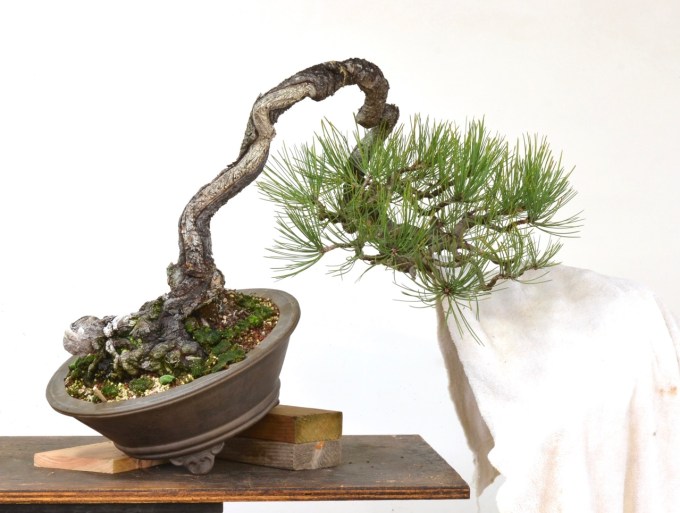New Design for an Awarded Ponderosa Pine-
This bunjin pine won the Ben Oki award years ago, and then showed up on the cover of Bonsai Clubs International in 1992. The two and a half decades since, under the stewardship of several owners, have proven that Ponderosa does eventually ramify.
In the last few years, however, the lower branch has weakened—made worse by an outbreak of needle cast—and so when the pine came into the yard a year ago we faced a choice.
A bonsai with some legacy attached can slow down your decision-making to a crawl. But bonsai change, and we are given the opportunity to change our ideas when they do. Here are a few photos of operation day-

Ponderosa Pine shortly after winning the Ben Oki award, on the cover of BCI in 1992

The pine in 2018, showing the weak cascade branch

A thought for a new inclination

Another thought: Remove the weak low branch

Removal

This is not a cut that would have been advisable much earlier in the tree’s history, as there wasn’t enough ramification to make the branch removal decision float. And that’s not just aesthetics—the tree needs enough buds and twigginess and foliage to maintain a ramified root system. Now it has that, we were able to be adventuresome in our design. Shortening and compacting the design brings the focus back to those areas. Though the branches are not yet adjusted for this new presentation, this is where we left it for the day. We’ll check back in once the tree is rewired and potted at this inclination.

11 Comments
Good decision
Great photo series! Even with our “non legacy” trees, we should be open to design changes as the tree matures – and (hopefully) our design asthetics mature as well. This tree’s trunk is unmistakeable. The changes will only make this bonsai even more of a head turner.
That is ace!
Do you think the upper more vigorous growrh and being at the bottom of the cascade had anything to do with ot weakening?
I like the more compact version which seems to have more balance
Yes, nearly all cascades have this problem and careful management can usually prevent severe weakening of the bottom branch. Under normal conditions. I think the whole tree was weakened in the past, and when that happens the lowest parts of an apically dominant tree, as pines are, get the worst of it.
26 years is a long time to wait. But it was worth the wait. Was the tree ever given a bigger pot to grow out. I ask because the root flair is spectacular!
Luckily I wasn’t doing the waiting~
This was always in a smaller pot. The trunk and root flare you see was essentially unchanged since the day it was collected. Ponderosa don’t develop trunk girth much at all in a pot. And the root flare was buried in the pot for many of the early years.
This post is a great example of how the root base can change the design options as it develops over the decades. Encouraging to note the ramification possible with Ponderosa.
Couldn’t a Jin be incorporated on the branch that was removed?
One could, yes. The part that one would likely want to make jin out of was straight as an arrow, though, so I decided not to. I don’t care for much jin on Bunjin anyhow, often takes away from the trunk. But yes, one could consider interesting looking jin.
I like your work very well done can’t wait to see more pictures of it .